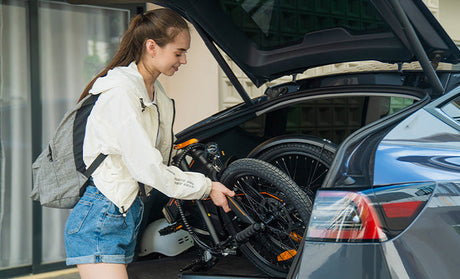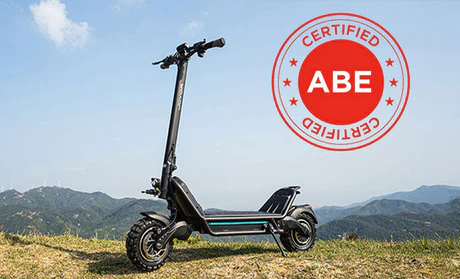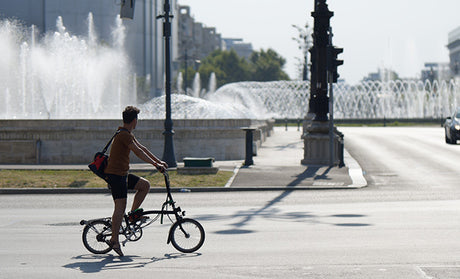Choosing the right mode of transportation can have a significant impact on your daily life, your commuting experience, and even your health. As the popularity of electric scooters and bicycles grows, understanding the differences between the two is essential to making an informed decision. This article provides a detailed comparison of Electric Scooters and bicycles, covering everything from cost, ease of use, environmental impact, and more.

Contents
- Comparison Overview
-
Cost and Affordability
1. Initial purchase price
2. Maintenance costs
3. Long-term investment -
Ease of Use
1. Learning curve for beginners
2. Maneuverability and maneuverability
3. Storage and portability -
Speed and Distance Traveled
1. Average speed comparison
2. Distance traveled per charge or ride
3. Factors affecting speed and distance traveled -
Environmental Impact
1. Emissions and sustainability
2. Energy consumption
3. Lifespan and recyclability -
Health Benefits
1. Provides physical activity
2. Cardiovascular benefits
3. Mental health benefits -
Safety Considerations
1. Risk of accidents and injuries
2. Required protective gear
3. Road safety regulations -
Convenience and Accessibility
1. Availability of charging stations
2. Parking and storage options
3. Suitable for different ages -
Weather and Terrain Adaptability
1. Performance in various weather conditions
2. Suitable for different terrains
3. Durability and sturdiness -
Maintenance and Repairs
1. Frequency and complexity of maintenance
2. Availability of repair services
3. Common problems and repairs -
Laws and Regulations
1. Age and license requirements
2. Speed limits and road use
3. Local regulations and restrictions -
Technical Features
1. Advanced features and gadgets
2. App integration and connectivity
3. Future trends and innovation -
Storage and Portability
1. Folding and compact designs
2. Storage solutions for home and workplaces
3. Public transportation -
User Preferences and Scenarios
1. Commuting to get off work or school
2. Leisure and recreational uses
3. Specific user scenarios and needs - Conclusion
- FAQ
Comparison Overview
| Aspect | Electric Scooters | Bicycles |
|---|---|---|
| Initial Purchase Price | $300 to $2,000 | $300 to $1,000 |
| Maintenance Costs | Higher | Lower |
| Long-Term Investment | Frequent replacements | Longevity with proper care |
| Learning Curve | Easier | Requires more skill |
| Handling and Maneuverability | Good | Excellent |
| Storage and Portability | Compact and foldable | Larger, but bike racks available |
| Average Speed | 15 to 25 mph (45 mph) | 10 to 20 mph |
| Range per Charge/Ride | 15 to 40 miles | Often 50+ miles |
| Emissions | Minimal | Zero |
| Energy Consumption | Low | None |
| Lifespan and Recyclability | Shorter, harder to recycle | Longer, easier to recycle |
| Physical Exercise | Minimal | Full-body workout |
| Cardiovascular Benefits | Minimal | Significant |
| Mental Health Benefits | Stress reduction | Boosts mood and well-being |
| Accident Risk | Moderate | Moderate |
| Protective Gear | Helmets, wrist guards | Helmets, pads |
| Road Safety Regulations | Varies by location | Varies by location |
| Charging Requirements | Requires charging | None |
| Parking and Storage | Easy indoors | Needs bike racks |
| Accessibility | Adjustable handlebars | Suitable for all ages |
| Weather Adaptability | Less adaptable | More adaptable |
| Terrain Suitability | Smooth surfaces | Various terrains |
| Durability | Delicate electronics | Sturdy frames |
| Maintenance Frequency | Less frequent | Regular maintenance |
| Repair Services | Specialized | Widely available |
| Common Issues | Battery, electronics | Flat tires, chains |
| Legal Regulations | Age and license requirements | Generally fewer restrictions |
| Speed Limits | Often restricted | Generally fewer restrictions |
| Community and Social Use | Emerging communities | Established communities |
| Recreational Enjoyment | Fun and effortless | Physical exercise |
| Technological Features | Advanced gadgets | GPS, fitness monitors |
| App Integration | Common | Common |
| Future Innovations | Battery tech, connectivity | Materials, performance enhancements |
| Folding Designs | Often foldable | Some folding models |
| Public Transit | Easier to transport | Varies by region |
| Commuting | Convenient | Exercise and versatility |
| Leisure Use | Fun exploration | Physical exercise |
| Specific Needs | Limited mobility | Fitness enthusiasts |
Cost and Affordability
Initial purchase price
Compared to bicycles, electric scooters generally have a higher initial purchase price. While quality bicycles can range from €300 to €1,000, electric scooters typically cost between €500 and €2,000, depending on features and brand. Of course, there are cheaper electric scooters, too, with prices below €500, such as JOYOR's e-scooters, which are legal to drive on the road and do not require a driver's license.
Maintenance costs
Because bicycles have simpler mechanical systems, maintenance costs are generally lower. Regular maintenance, such as changing tires and adjusting brakes, is relatively cheap. On the other hand, electric scooters may require more expensive repairs, especially battery replacements and electronic component repairs.
Long-term investment
When considering long-term investment, both options have their pros and cons. If properly maintained, bicycles can last for many years, while electric scooters may require more frequent replacement of batteries and electronic parts. However, electric scooters can save on transportation costs if they replace car trips or public transportation expenses.

Ease of Use
Learning curve for beginners
Bicycles require a certain level of skill and balance, especially for beginners. Learning to ride a bicycle may take some time and practice. However, electric scooters are generally easier to master, and most people can ride comfortably after a short practice session.
Maneuverability and maneuverability
Bicycles have excellent maneuverability, especially in crowded urban areas. They can easily navigate traffic and tight spaces. Electric scooters are also highly maneuverable, but their smaller wheels and standing position may make them less stable on uneven surfaces compared to bicycles. Of course, the tire size of electric scooters corresponds to different terrains. Read related article: Comparison of Different Tire Sizes for Electric Scooters
Storage and portability
Electric scooters have the advantage of being more compact and portable. Many models are foldable, making them easy to carry and store in small spaces, and can also be placed in the trunk or taken on the subway. Bikes, while larger, can be stored in a bike rack and are usually easier to secure with a lock.

Speed and Distance Traveled
Average speed comparison
Electric scooters are generally faster than bicycles, with average speeds between 15 and 25 mph, although more powerful e-scooters can reach higher and faster speeds, up to 45 mph. Bicycles typically have speeds of 10 to 20 mph, depending on the rider's fitness level and the terrain.
Distance traveled per charge or ride
Electric scooters have a limited range per charge, typically between 15 and 40 miles, depending on the model and battery capacity. Bicycles are human-powered and can travel farther, with riders typically able to travel 50 miles or more in a day, depending on the user's strength and stamina.
Factors affecting speed and distance traveled
Both electric scooters and bicycles are affected by factors such as terrain, weather, and rider weight. Hills and rough surfaces reduce speed and distance traveled, while smooth, flat surfaces improve performance.

Environmental Impact
Emissions and sustainability
Both electric scooters and bicycles are environmentally friendly choices compared to cars. Bicycles rely on human power, so they have zero emissions. Electric scooters produce minimal emissions, mainly during manufacturing and charging, but they are still a more sustainable choice than fuel-powered cars.
Energy consumption
In terms of energy consumption, bicycles are the clear winner, requiring no external power source. Electric scooters consume electricity, but energy usage is relatively low, especially compared to cars or motorcycles.
Lifespan and recyclability
Bicycles generally have a longer lifespan and are easier to recycle at the end of their use. Electric scooters, with their batteries and electronic components, present more recycling challenges but are gradually improving in this aspect with advancements in technology.

Health Benefits
Provides physical activity
Bicycles offer significant health benefits by providing a full-body workout, improving cardiovascular health, and building muscle strength. E-scooters offer less physical activity because they do not require pedaling and primarily work the lower body for balance and control.
Cardiovascular benefits
Regular cycling is known to improve cardiovascular health, reduce the risk of heart disease, and increase overall endurance. The cardiovascular benefits of riding an e-scooter are minimal compared to riding a bicycle.
Mental health benefits
Both modes of transportation can improve mental health by reducing stress and promoting a sense of freedom. Cycling, in particular, can improve mood and mental health through physical activity and outdoor time.

Safety Considerations
Risk of accidents and injuries
Both e-scooters and bicycles present a risk of accidents and injuries, especially in busy urban environments. Proper safety gear, such as helmets and reflective clothing, is essential for both.
Read related safe riding articles:
Safety Precautions for Riding an Electric Bike: a Must-read for Newbies?
What does Gordon Ramsay's Bike Accident tell us?
Required protective gear
Helmets are essential equipment for both e-scooter and bicycle riders to prevent head injuries. Additionally, bicycle riders may need knee and elbow pads, while e-scooter riders should consider wrist guards for added protection.
Road safety regulations
E-scooters and bicycles are subject to road safety regulations, which vary by location. Riders should familiarize themselves with local laws, such as helmet requirements, speed limits, and designated riding areas.

Convenience and Accessibility
Availability of charging stations
E-scooters need to be charged, which can be a limitation if charging stations are not conveniently available. However, many riders charge their scooters at home or at work. Bicycles do not have this limitation because they do not require an external power source.
Parking and storage options
In urban environments, bicycles often have designated parking areas and racks, while e-scooters can be folded up and stored more easily indoors. Both options require secure locking mechanisms to prevent theft.
Suitable for different ages
Bicycles and e-scooters are suitable for people of all ages. Bicycles with smaller frames and lower gears are suitable for children, while e-scooters with adjustable handlebars can accommodate people of all heights and ages.

Weather and Terrain Adaptability
Performance in various weather conditions
Both bicycles and e-scooters can be affected by weather conditions. Rain and snow can make riding slippery and dangerous. E-scooters have smaller wheels and may struggle more in inclement weather than bicycles.

Suitable for different terrains
Bicycles are generally more versatile and can handle a variety of terrains, including off-road trails. Electric scooters are best suited for smooth paved surfaces and may not perform as well on rough or uneven surfaces.
Durability and sturdiness
Bicycles are generally more durable and sturdy, with sturdy frames that can withstand a variety of conditions. Electric scooters, while durable, may have more delicate electronic components that require careful handling.
Read related article: Maintenance Tips for Electric Scooter

Maintenance and Repairs
Frequency and complexity of maintenance
Bicycles require regular maintenance, such as chain lubrication, tire inflation, and brake adjustment, which are relatively simple and can usually be done at home. E-scooters may require more specialized battery and electronic system maintenance.
Availability of repair services
Bicycle repair services are widely available and generally affordable. E-scooters may require specialized repair services, which may be more expensive and harder to find. However, for OOLACTIVE e-bike and e-scooter stores, we have warranties on both e-bikes and e-scooters, and we will replace the product or accessories as needed, and the after-sales service is very fast.
Common problems and repairs
Common bicycle problems include flat tires and chain problems, which are usually easy to fix. E-scooters may face battery problems, motor problems, and electronic failures, which may be more complicated to diagnose and repair.

Laws and Regulations
Age and license requirements
Laws and regulations for e-scooters and bicycles vary from region to region. Some areas have age restrictions and may require an e-scooter license, while bicycles generally do not have such requirements.
Speed limits and road use
E-scooters generally have speed limits and may be prohibited from driving on certain roads and bike paths. Bicycles are generally freer to use roads, bike lanes, and trails.
Local regulations and restrictions
Local regulations can vary widely, and some cities have specific rules for e-scooters, such as designated parking areas and restricted areas. Bicyclists also need to comply with local traffic laws and regulations.

Technical Features
Advanced features and gadgets
Electric scooters are often equipped with advanced features such as LED lights, digital displays, and app connectivity. Bikes can also be equipped with gadgets such as GPS trackers, smart locks, and fitness monitors.
App integration and connectivity
Many electric scooters feature app integration, allowing riders to track their rides, monitor battery levels, and adjust settings. Bikes can also utilize apps for route planning, fitness tracking, and social networking.
Future trends and innovation
The future looks bright for both electric scooters and bikes, with constant innovation aimed at improving performance, safety, and convenience. Advances in battery technology, materials, and connectivity will continue to enhance both modes of transportation. And now there are electric bikes, making it easier and faster to get to your destination and get there.

Storage and Portability
Folding and compact designs
Electric scooters are often designed to be foldable and compact, making them easier to carry and store. Some bikes also feature folding designs, but they tend to be bulkier than scooters.
Storage solutions for home and workplaces
Both electric scooters and bikes require secure storage solutions. Due to their compact size, scooters can be stored indoors, while bicycles may require a designated bike rack or secure storage area.
Public transportation
E-scooters are often easier to transport on public transportation due to their compact size and foldability. Bicycles can also be carried on public transportation, but space and restrictions may vary by region.

User Preferences and Scenarios
Commuting to get off work or school
For commuting, the choice between an e-scooter and a bicycle depends on factors such as distance, terrain, and personal preference. E-scooters offer a convenient and sweat-free option, while bicycles offer exercise and versatility.
Leisure and recreational uses
Both e-scooters and bicycles are well suited for leisure and recreational uses. Bicycles offer the added benefit of physical exercise, while e-scooters offer a fun and easy way to explore new areas.
Specific user scenarios and needs
Different users may have specific needs that make one option more appropriate than another. For example, someone with limited mobility may prefer the convenience of an e-scooter, while a fitness enthusiast may opt for the physical benefits of cycling.

Conclusion
In conclusion, both electric scooters and bicycles have their unique advantages and are suitable for different purposes. Electric scooters are convenient, easy to use, and great for short commutes, while bicycles offer significant health benefits, versatility, and a strong sense of community. Ultimately, the choice between an electric scooter and a bicycle depends on your personal preferences, lifestyle, and specific needs.
FAQs
Which is more cost-effective, an electric scooter or a bicycle?
Bicycles are generally more cost-effective due to lower initial costs and maintenance expenses.
Are electric scooters faster than bicycles?
Electric scooters typically offer higher speeds, ranging from 15 to 25 mph, compared to bicycles.
Which option is better for the environment?
Both are environmentally friendly, but bicycles have zero emissions and do not require external power sources.
Do electric scooters require a license?
Licensing requirements vary by region, with some areas requiring a license for electric scooters.
Can I use an electric scooter in the rain?
It's possible to use electric scooters in light rain, but caution is advised due to slippery surfaces and potential water damage to electronic components.










